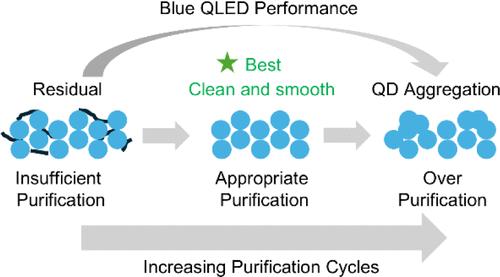量子点净化对蓝量子点发光二极管的影响
IF 3.9
2区 化学
Q2 CHEMISTRY, MULTIDISCIPLINARY
引用次数: 0
摘要
量子点(QDs)在高亮度、高色纯度的量子点发光二极管(qled)中显示出了巨大的潜力。蓝光QLED寿命短是目前QLED商业化的一大障碍。配体钝化量子点表面缺陷,对量子点性能起着至关重要的作用。然而,在应用前必须使用沉淀-离心-再溶(PCR)方法纯化量子点以去除残留物。纯化会导致配体损失,从而不可避免地增加表面缺陷,这对器件性能是不利的。在本研究中,我们合成并表征了具有ZnCdSe/ZnSe/ZnCdS结构的蓝色量子点,并研究了PCR纯化周期对量子点薄膜形貌的影响。然后我们研究了形态对QLED性能的影响。结果表明,残留最小、粗糙度最低的QD薄膜电流效率最高,为10.3 cd/A, EQE最高,为15.3%,T95运行时间最长,亮度为1000 cd/m2 (T95@1000 cd/m2)为105 h。研究结果表明,优化纯化工艺对实现稳定的蓝色qled具有重要意义。本文章由计算机程序翻译,如有差异,请以英文原文为准。

Influence of Quantum Dot Purification on a Blue Quantum Dot Light-Emitting Diode
Quantum dots (QDs) have demonstrated their potential in QD light-emitting diodes (QLEDs) with high brightness and color purity. The short lifetime of blue QLEDs is currently a big obstacle for QLED commercialization. Ligands passivate surface defects of QDs and play a vital role in QLED performance. However, QDs must be purified using the precipitation-centrifuge-redissolution (PCR) method to remove residuals before application. Purification leads to ligand loss and thus an inevitable increase in surface defects, which is detrimental to device performance. In this study, we synthesized and characterized blue QDs with a ZnCdSe/ZnSe/ZnCdS structure and investigated the influence of PCR purification cycles on QD thin film morphologies. We then investigated the effect of morphology on QLED performance. It was found that the QD film with minimal residuals and the lowest roughness demonstrated the highest current efficiency of 10.3 cd/A, the highest EQE of 15.3%, and the longest T95 operation time at a luminance of 1000 cd/m2 (T95@1000 cd/m2) of 105 h. Our work demonstrates the significance of an optimized purification process for achieving stable blue QLEDs.
求助全文
通过发布文献求助,成功后即可免费获取论文全文。
去求助
来源期刊

Langmuir
化学-材料科学:综合
CiteScore
6.50
自引率
10.30%
发文量
1464
审稿时长
2.1 months
期刊介绍:
Langmuir is an interdisciplinary journal publishing articles in the following subject categories:
Colloids: surfactants and self-assembly, dispersions, emulsions, foams
Interfaces: adsorption, reactions, films, forces
Biological Interfaces: biocolloids, biomolecular and biomimetic materials
Materials: nano- and mesostructured materials, polymers, gels, liquid crystals
Electrochemistry: interfacial charge transfer, charge transport, electrocatalysis, electrokinetic phenomena, bioelectrochemistry
Devices and Applications: sensors, fluidics, patterning, catalysis, photonic crystals
However, when high-impact, original work is submitted that does not fit within the above categories, decisions to accept or decline such papers will be based on one criteria: What Would Irving Do?
Langmuir ranks #2 in citations out of 136 journals in the category of Physical Chemistry with 113,157 total citations. The journal received an Impact Factor of 4.384*.
This journal is also indexed in the categories of Materials Science (ranked #1) and Multidisciplinary Chemistry (ranked #5).
 求助内容:
求助内容: 应助结果提醒方式:
应助结果提醒方式:


